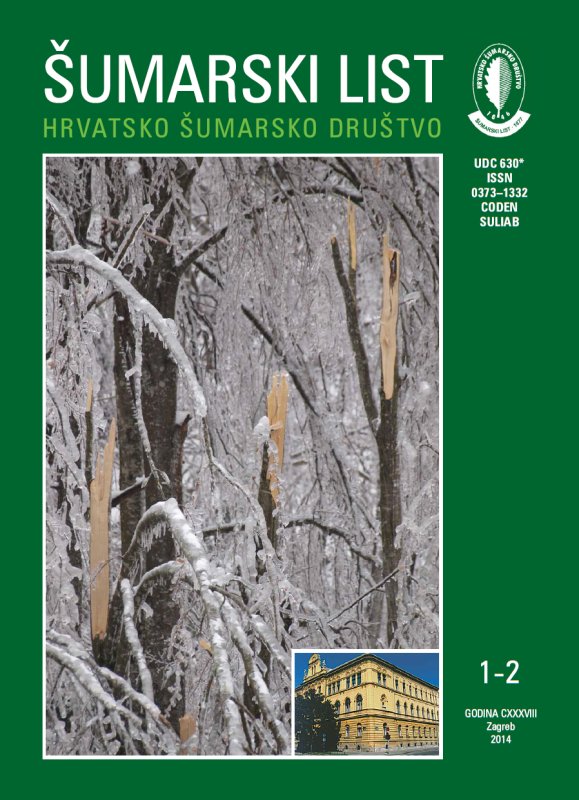
broj: 1-2/2014
pdf (5,91 MB) |
|
||||||||||||||
| RIJEČ UREDNIŠTVA | ||
| Uredništvo | ||
| FREEZING RAIN IN GORSKI KOTAR pdf HR EN | 5 | |
| At an elevation of about 3000 m asl, when the air temperature drops between 5 and 10 °C below zero, the snow developed in the clouds begins to fall. Passing through the warm layer between 800 and 2000 m above sea level, the snow melts and becomes rain. In the zone of cold air below 800 m the raindrops cannot revert to snow but continue falling as rain, which immediately freezes upon impact with any cold surface it encounters. In terms of meteorology, this is supercooled rain because the raindrop temperature is below 0 °C (it can also be below – 40 °C), but it freezes the moment it touches the ground. Such or a similar structure of air masses distributed across the elevations at which freezing rain develops, was formed within the Mediterranean Cyclone Ilija, which affected the weather in Croatia on Sunday, February 2nd, 2014, when a large part of Gorski Kotar was hit by freezing rain, causing havoc on state-owned and private holdings, in the nature and on the infrastructure. Forests, orchards and power transmission lines were heavily affected, the roads were glazed with ice, and the roads were partially or completely blocked for several days by fallen trees and ice-burdened branches leaning over the roads. About 80 % of the population (14,000 households) were left without electricity. The County Prefect proclaimed a state of natural disaster for the entire region. Rescue teams (forestry employees and forestry infrastructure, fire fighters, builders and others) that came to the area managed to restore the semblance of normal life over the next 10 days. It will take months and even years to remediate the damage incurred by the freezing rain and snow. Damage suffered by social and private subjects in the region is currently being assessed and submitted. In this report we will primarily focus on the damage incurred on and in the forests. Some time ago, the company "Hrvatske Šume Ltd", the Risnjak National Park and the Faculty of Forestry assessed the damage in the region under their management and are currently drawing up restoration programmes. Damage assessment was submitted, among others, to the Primorje-Gorski Kotar County, which will add it to the rest of the damage assessments, develop a restoration programme and apply to the EU Fund for help. According to the assessment made by the company "Hrvatske Šume Ltd", damage was incurred over 43,025 ha of state forests (including the Risnjak National Park) and 9,723 ha of private forests. The amount of damaged wood mass encompasses 2,494,651 m3 of technical wood (2,183,154 m3 in state forests + 311,497 m3 in private forests) and fuelwood 1,774,426 m3 (1,256,537 + 517,889). Excluding the Risnjak National Park which covers an area of 39,172 ha (29,449 + 9,723), as much as 1,517,544 m3 of technical wood and fuelwood (1,035,735 + 418,809) were damaged in the value of 285.185 million kn (214.312 + 70.813). The exploitable wood mass of technical wood and fuelwood was estimated at 750,234 m3 (483,175 + 267,059 m3), reaching 138.470 mil. kn (98.214 + 40.256 kn), which means that the damage rose to 146.655 mil. kn (116.097+ 30.558 kn). Damage on forest roads was assessed at 3.389 mil. kn, on forest tracks at 9.115 mil. kn, and work on public roads at 0.468 mil. kn. Damage in the National Park was assessed at 24.084 mil. kn., and the at the Faculty of Forestry facilities at 0.131 mil. kn. Naturally, cost of remediation should be added to these claims. Broadleaves were the most heavily affected. The percentage of destroyed wood mass ranges from 60 % in the forest offices of Rijeka, 48 % in Crni Lug, 43 % in Gerovo, 38 % in Fužine, 34 % in Tršće, 34 % in Prezid, 23 % in Lokve, 23 % in Delnice, 6 % in Mrkopalj, and 2% in Skrad to none in the forest offices of Ravna Gora, Vrbovsko and Gomirje. The average damage for the Delnice Forest Administration is 30 %. In view of these facts, all those responsible for the management and care for the forests in the afflicted areas are faced with an enormous professional challenge of damage restoration. We firmly believe that they are capable of responding to this challenge. Editorial Board | ||
| IZVORNI ZNANSTVENI ČLANCI | ||
| Igor Poljak, Marilena Idžojtić, Irena Šapić, Joso Vukelić, Marko Zebec | UDK 630*164 (001) | |
| POPULATION VARIABILITY OF GREY (Alnus incana /L./ Moench) AND BLACK ALDER (A. glutinosa /L./ Gaertn.) IN THE MURA AND DRAVA REGION ACCORDING TO THE LEAF MORPHOLOGY pdf HR EN | 7 | |
| Jaroslav Holuša, Emanuel Kula, Filip Wewiora, Karolina Lukášová | UDK 630*453 (001) | |
| FLIGHT ACTIVITY, WITHIN THE TRAP TREE ABUNDANCE AND OVERWINTERING OF THE LARCH BARK BEETLE (Ips cembrae) IN CZHECH REPUBLIC pdf HR EN | 19 | |
| Bojan GAVRILOVIĆ, Branka GAVRILOVIĆ, Srećko ĆURČIĆ, Dejan STOJANOVIĆ, Dragiša SAVIĆ | UDK 630*453 (001) | |
| LEAF BEETLES (COLEOPTERA: CHRYSOMELIDAE) OF MT. FRUŠKA GORA (VOJVODINA PROVINCE, NORTHERN SERBIA), WITH AN OVERVIEW OF HOST PLANTS pdf HR EN | 29 | |
| Ante P. B. KRPAN, Željko TOMAŠIĆ, Igor STANKIĆ | UDK 630* 537 + 562 (001) | |
| STUDY OF BIOPRODUCTIVE AND ENERGY POTENTIALS OF INDIGOBUSH (Amorpha fruticosa L.) pdf HR EN | 43 | |
| STRUČNI ČLANCI | ||
| Marko Zebec, Marilena Idžojtić, Igor Poljak, Maja Zebec | UDK 630*272 | |
| DENDROFLORA AND HARMONY OF THE ARCHITECTURAL AND HORTICULTURAL ELEMENTS OF THE PARK SURROUNDING THE FACULTY OF FORESTRY AND THE FACULTY OF AGRICULTURE AT THE UNIVERSITY OF ZAGREB pdf HR EN | 55 | |


